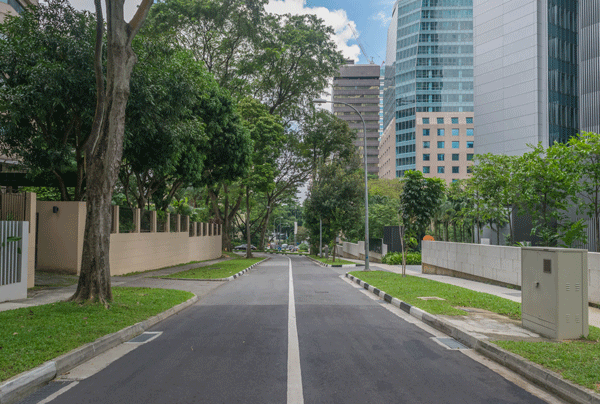 I’ve long advocated for skinny local road standards and implementing “road diets” for existing streets. While often controversial, the idea of narrow streets just makes sense. Streets largely determine the “feel” and livability of our neighborhoods. Narrow streets increase the sense of connection between those living in a community, decrease travel speeds, increase safety, decrease construction and long-term O&M costs, and dramatically reduce environmental impacts (for both stormwater and the “heat island” effect of asphalt). And to me, neighborhoods built around narrow street sections just feel right.
I’ve long advocated for skinny local road standards and implementing “road diets” for existing streets. While often controversial, the idea of narrow streets just makes sense. Streets largely determine the “feel” and livability of our neighborhoods. Narrow streets increase the sense of connection between those living in a community, decrease travel speeds, increase safety, decrease construction and long-term O&M costs, and dramatically reduce environmental impacts (for both stormwater and the “heat island” effect of asphalt). And to me, neighborhoods built around narrow street sections just feel right.
Conversely, the evidence is overwhelming that wide-roads result in higher speeds and increased traffic-related fatalities. The impact is dramatic. The 1997 Swift-Painter-Goldstein Study concluded that fatalities increase by 485% per year per mile as road widths increase from 24 to 36 feet. Put simply: speed kills, and the most effective way to decrease speeds on local streets is to limit road widths.
Emergency response professionals often express concerns about their ability to navigate narrow streets with large fire trucks and equipment. Of course, we shouldn’t ignore the concerns of our emergency response providers. However, I believe good planning and policy encourage solutions that address emergency response concerns. For instance, highly-networked and interconnected streets increase the number of emergency response routes. Off-street parking and parking restriction and enforcement are other ways to provide clear roads and address emergency response concerns. Finally, in-home sprinkler systems allow more time to respond and could be used as a way to provide further flexibility in street widths.
The International Fire Code (IFC) is usually cited as the roadblock to the adoption of narrow street standards. Specifically, the Code has a 20-feet clear road rule for the passage of emergency response vehicles in either direction. However, numerous jurisdictions have interpreted these limitations differently. The most significant departures from these standards have been led by the States of Oregon and Washington. Both have adopted the IFC, but have then allowed local jurisdictions to override the 20-foot clear rule (See Oregon Revised Statutes, 368.039 the Revised Code of Washington, 19.27.060 [5] and WAC 51-54-007). Washington and Oregon understand it’s important to provide flexibility where appropriate.
This is a big topic which deserves more attention than I can give it in this blog post. My interest in sharing these thoughts is to encourage more consideration of the real impact of overbuilt local streets. Good design will prevail if productive and thoughtful discussion occurs between the development community, design professionals, and emergency responders. Additionally, narrow-street standards are an important part of the “complete streets” approach to provide sustainable infrastructure that better accommodates pedestrians and all modes of transportation. I hope local agencies can build flexibility into their standards so the development community can provide variety in neighborhood design.
I’d love to hear your perspective on this issue.
-
Are you a developer who has encountered roadblocks in implementing skinny street projects?
-
Has your agency adopted successful standards that support narrow streets and provide flexibility to the development community?
-
Is there agreement between engineering, planning, and emergency response professionals on these topics in your area?
Please either leave a comment below or contact me via email at dsmith@mackaysposito.com.
Note: The P. Swift, D. Painter, and M. Goldstein, "Residential Street Typology and Injury Accident Frequency," study originally presented at the Congress for the New Urbanism, Denver, CO in June 1997 analyzed 20,000 police reports in Longmont Colorado to determine how street widths and design impacted collision numbers.

